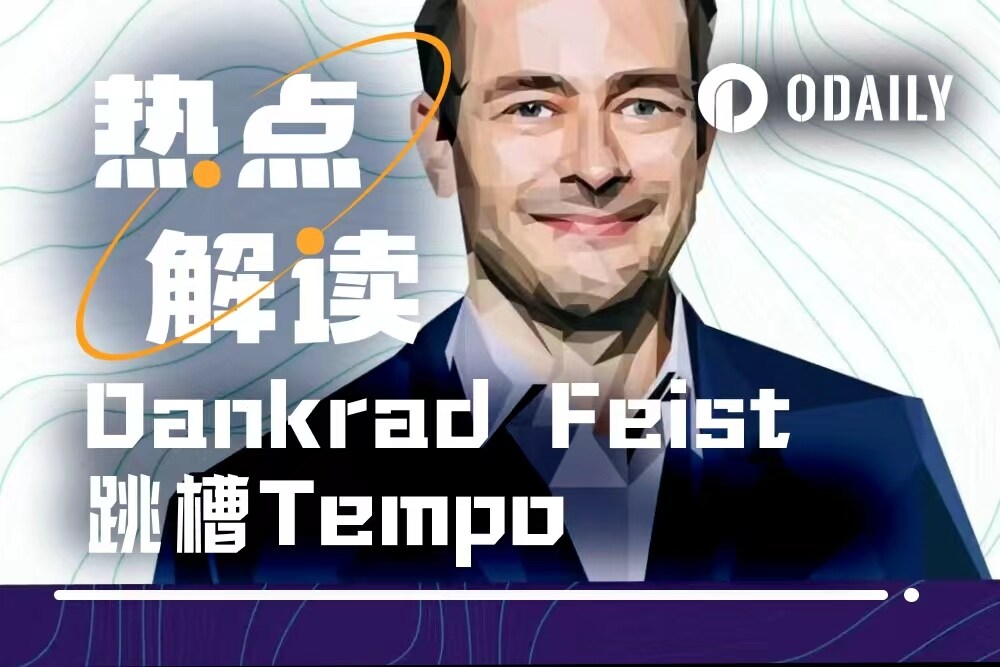Ethereum's "Godfather of Scaling" has jumped ship! A look back at Dankrad Feist's legendary journey
- 核心观点:以太坊核心研究员离职投身支付赛道。
- 关键要素:
- Dankrad Feist主导Danksharding等关键扩容技术。
- 以太坊开发者薪酬远低于私营企业水平。
- Tempo获50亿美元估值专注支付优化。
- 市场影响:加剧公链人才竞争与支付赛道关注。
- 时效性标注:短期影响
Original | Odaily Planet Daily ( @OdailyChina )
Author|jk
On October 17, 2025, a tweet sent shockwaves through the Ethereum community. Dankrad Feist, a core researcher at the Ethereum Foundation, announced on Twitter that he would be leaving his full-time position at the Ethereum Foundation to join a blockchain company called Tempo. The news quickly spread throughout the crypto community, with even Ethereum founder Vitalik Buterin personally responding: "Dankrad has been an exceptional researcher and has made tremendous contributions to the Ethereum we know and love today, including Danksharding, consensus research, and more."
So, who exactly is Dankrad Feist, the man who has captured the attention of the entire Ethereum community? From a PhD in nuclear physics to the creator of the Ethereum scaling solution, and now a leader in the blockchain payments revolution, his story is truly legendary.
A decade-long transformation journey for a scholar-tech genius
If you thought Dankrad Feist was a cryptocurrency enthusiast from the start, you'd be wrong. The German's academic career began at the Department of Applied Mathematics and Theoretical Physics at the University of Cambridge , where Stephen Hawking once worked. In 2013, Feist completed his doctorate in theoretical physics at Cambridge, focusing on skyrmions—a mathematical model used to describe the interactions between atomic nuclei. His doctoral thesis delved into the interaction of B=4 skyrmions, findings that have important implications for understanding the behavior of alpha particles (helium nuclei).
This might sound far-fetched, but it was this deep foundation in mathematics and physics that laid the foundation for Feist's subsequent breakthroughs in cryptography. His doctoral dissertations involved complex numerical methods and multipolar theory, skills that later proved useful in designing blockchain scaling solutions.
Interestingly, while completing his PhD, Feist began to develop a “casual” interest in this new thing called “Bitcoin” - the time was 2013, which was the key year when Bitcoin began to move from the geek circle to the public eye.
Entrepreneurship Interlude: From Scholar to Entrepreneur
After receiving his doctorate in 2013, Feist chose not to remain in academia for a postdoc but instead jumped into the tech industry. In 2016, he co-founded Cara Care, a health tech company specializing in personalized digestive health solutions. Meanwhile, Feist's interest in cryptocurrency gradually deepened. This journey, from a casual introduction in 2013 to a deeper understanding of the mathematical and cryptographic foundations of blockchain, took several years. He began to realize that many of the challenges in blockchain technology—such as consensus mechanisms, cryptographic proofs, and network scalability—required the mathematical tools in which he excelled.
Joining Ethereum: From Part-time Researcher to Core Contributor
In 2018, Feist began working for the Ethereum Foundation on a part-time basis. In 2019, he officially became a full-time core researcher. This decision changed the trajectory of his life and profoundly influenced the direction of Ethereum's development. At the Ethereum Foundation, Feist focused on scaling Ethereum, with a particular focus on applied cryptography, secure multi-party computation (MPC), and zero-knowledge proofs. He quickly demonstrated his ability to translate advanced theory into practical solutions.
"Danksharding": The scaling revolution named after him
Feist's most famous contribution is undoubtedly "Danksharding," a sharding design that bears his name. This design aims to improve Ethereum's data availability through an MPC-friendly proof-of-custody protocol and a new sharding structure.
Simply put, sharding involves chopping blockchain data into smaller pieces, allowing different nodes to process different portions, significantly increasing the network's processing power. However, Feist's innovation lies in his design of a Data Availability Sampling (DAS) mechanism, which ensures that even in a sharded environment, the network can verify that all necessary data is available.
The importance of this proposal cannot be overstated. Even Ethereum’s EIP-4844 (known as “proto-danksharding”) is named after Feist’s contribution, which is an important first step towards full sharding on Ethereum.
EIP-9698: A Crazy Proposal for 100x Capacity Expansion
If Danksharding demonstrated Feist’s technical depth, his EIP-9698, proposed in April 2025, showcased his bold vision. This proposal calls for an exponential 100-fold increase in Ethereum’s gas limit over four years, from the current 36 million to 3.6 billion.
If this proposal is adopted, Ethereum could theoretically reach a processing speed of 2,000 transactions per second, directly competing with high-performance chains like Solana. Feist's plan is to exponentially increase the gas limit with each beacon chain epoch, starting on June 1, 2025, with a roughly tenfold increase every two years.
This proposal sparked heated debate in the community. Supporters argued that it would significantly improve Ethereum's performance while maintaining decentralization, while critics worried about the pressure it would put on node operators. Feist's response was pragmatic: "The exponential growth plan provides gradual increases in each epoch, giving node operators and developers ample time to adapt and optimize."
Other technical contributions: From Verkle trees to zero-knowledge proofs
Beyond these star projects, Feist has made profound contributions across multiple layers of the Ethereum technology stack. In the research on Stateless Ethereum, he was a key figure in driving the development of this key technology. He championed the use of Verkle trees, an advanced cryptographic data structure, as an alternative to traditional Merkle trees. This allows nodes to verify transactions without storing the full blockchain state, significantly lowering the hardware requirements for running Ethereum nodes.
At the same time, he fully utilized his profound mathematical foundation in the field of zero-knowledge proofs, devoting significant effort to KZG polynomial commitments and various zk-SNARK optimization techniques. These seemingly abstract cryptographic tools have now become the core technical foundation of Layer 2 solutions such as Optimism and Arbitrum . Equally important is his pioneering work in data availability. His design of an MPC-friendly data custody proof protocol addresses a key issue in sharding: how to ensure that validators actually store the data they are supposed to store? This protocol allows validators to cryptographically prove that they hold shard data without actually revealing the entire content, which is crucial for Ethereum's long-term scaling strategy.
Why leave? "It's time to pay" or "It's time to get paid"
In a statement on Twitter on October 17, Feist wrote:
“I’m excited to announce that I’m joining Tempo. This past year has been a turning point for the crypto industry, as we’re finally seeing the outlines of our original vision begin to take shape. Payments were central to crypto’s early days, and now I see a unique opportunity: with relentless execution on both the technology and distribution sides, we can finally achieve this ambitious goal.
I believe the time to connect to the real world is now , and I want to ensure we don't miss out on this window into the lives of everyday people around the world. For the past few years, I've focused on blockchain architecture and scaling; now, I'm excited to translate that experience, along with the strong team Tempo is building, into real, practical results...
Ethereum has a unique set of values and technology choices that set it apart from the rest of the world. Tempo will be a perfect complement: it builds on similar technology and values while enabling breakthroughs in scale and speed. I believe this will greatly benefit Ethereum. Tempo's open-source technology can be easily back-ported and integrated into Ethereum, benefiting the entire ecosystem. Ethereum and Tempo are highly aligned, both embracing the ideal of permissionlessness. I look forward to continuing to engage with the community and driving Ethereum forward!
Notably, Feist emphasized that this isn't a complete "farewell." He will continue to serve as a research advisor to the Ethereum Foundation, focusing on areas such as L1 scaling, blobs, and user experience improvements. In his view, Tempo and Ethereum are "strongly aligned" because they are both built on the same permissionless philosophy.
The Money Factor: The Nonprofit vs. Private Sector Pay Gap
While Feist’s public statements have emphasized technical vision and timing, the timing of his departure highlights a growing problem in the crypto industry: competitive salaries for top talent.
According to a recent survey by Protocol Guild, the median salary for Ethereum core developers is only $140,000, and only 37% receive equity or token rewards from their employers. The report bluntly states that Ethereum core developers "can earn double the salary on other blockchain projects."
Even more dramatically, just a few days before Feist announced his resignation, Péter Szilágyi, a core developer of Ethereum’s Geth client, publicly criticized the Ethereum Foundation’s salary policy, revealing that his total income in six years was only $625,000 (before tax) , while Ethereum’s market value grew from near zero to nearly $450 billion during the same period.
According to salary website Levels.fyi, salaries at the Ethereum Foundation range from $117,000 to $155,000, with the median salary for software engineers being $155,000. By comparison, an entry-level employee at Coinbase earns a base salary of $150,000, plus $56,000 in stock and bonuses.
Tempo, on the other hand, is in a completely different situation. Having just raised $500 million in Series A funding at a $5 billion valuation, the company clearly has the financial muscle to offer a competitive compensation package.
Feist's departure comes at a time of increasing corporate investment in building Layer-1 blockchains, reflecting the private sector's aggressive poaching of top blockchain talent. Notably, Feist and his colleague Justin Drake were previously forced to resign from EigenLayer advisory positions in 2024 following a conflict of interest controversy. This highlights the Ethereum Foundation's strict restrictions on external revenue sources.
So, maybe this job change was really because of income.
Tempo: A new attempt at a dedicated payment blockchain, a new king-level project
So, what is Tempo? A blockchain project jointly incubated by payment giant Stripe and crypto investment fund Paradigm, it’s a truly top-tier project.
In October of this year, it completed a $500 million Series A funding round, valuing the company at $5 billion, making it one of the largest rounds in the crypto space in 2025. But more importantly, its technological vision lies in its mission: a blockchain specifically optimized for payments. Unlike general-purpose blockchains like Ethereum, Tempo has been optimized from the outset for high-frequency, low-cost stablecoin payments. Its goal sounds a bit audacious: to process over 100,000 transactions per second, with transaction confirmation times of less than one second.
To achieve these targets, Tempo has made numerous innovations in its technical architecture: users can pay transaction fees directly with stablecoins without having to hold special tokens; it supports ISO 20022 standard transaction notes to facilitate corporate reconciliation; it offers a batch transfer function suitable for scenarios like payroll ; and it also provides optional privacy protection and compliance tools.
Looking back at Feist's career trajectory, you'll notice an interesting pattern: he consistently made pivots at crucial points in technological maturity. From theoretical physics to health tech, from entrepreneurship to blockchain research, and from the Ethereum Foundation to the payments-focused Tempo, each transition coincided with a window of opportunity for technological development.
This transformation from basic research to specific applications, to some extent, also reflects the development trajectory of the entire blockchain industry: from the proof-of-concept stage to the large-scale practical application stage.



